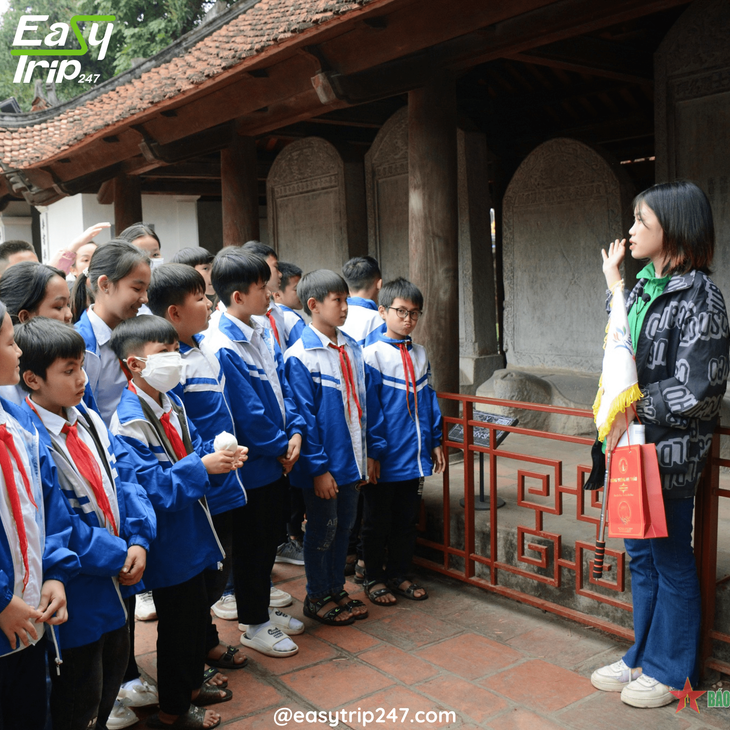Why Students Should Visit the Temple of Literature in Hanoi
On
23/06/2025Reading time:
1 min
Summary:
For any student—whether in Vietnam or visiting from abroad—the Temple of Literature Hanoi is more than just a popular tourist site. It’s a symbol of knowledge, perseverance, and the long-standing reverence for education in Vietnamese culture.

Built in 1070 under Emperor Lý Thánh Tông and dedicated to Confucius, the Temple of Literature Hanoi was Vietnam’s first national university. It educated the country's brightest minds, preparing them for civil service exams that determined leadership and governance roles. For modern-day students, this represents a powerful connection to the past—one that emphasizes the value of learning and the importance of dedication to one’s studies. Visiting the Temple of Literature Hanoi gives students a chance to walk in the footsteps of scholars who changed the course of Vietnamese history.
As soon as students step through the grand entrance gate of the Temple of Literature Hanoi, they are immersed in a peaceful sanctuary far removed from the bustle of city life. The temple grounds, divided into five serene courtyards, are filled with ancient trees, well-manicured gardens, and lotus ponds that inspire reflection and calm. For students, especially those overwhelmed by exams or coursework, the tranquil setting can be a mental reset. The environment encourages mindfulness, which is essential for learning and retaining knowledge. The temple grounds are also ideal for group visits and school excursions, allowing students to bond, explore, and grow together.
One of the most significant parts of the Temple of Literature Hanoi is the area housing the Stelae of Doctors. These 82 stone turtles hold engraved slabs honoring the scholars who passed the royal exams from the 15th to the 18th century. For a student, reading the names and accomplishments of these ancient academics isn’t just educational—it’s motivational. It shows how merit and effort have always been celebrated in Vietnamese society. The presence of these stelae reinforces the idea that with hard work and dedication, students too can leave a mark on the world.
The Temple of Literature Hanoi is also a source of inspiration through its rich symbolism. Everywhere you turn, there are images of cranes and turtles—symbols of longevity and wisdom. The architecture itself is designed with balance in mind, drawing on Confucian principles of harmony and order. These symbols serve as subtle but powerful reminders of the ideals students can strive toward: patience, intelligence, and moral integrity. It’s not just a visual feast, but a philosophical one, encouraging young people to think beyond their textbooks and embrace values that support lifelong learning.
Language and literature students will find particular joy in visiting the Temple of Literature Hanoi, as it offers a glimpse into Vietnam’s early written traditions. Ancient texts, calligraphy, and classical Chinese inscriptions line the walls and gates, reflecting the scholarly culture of the time. Understanding these literary traditions allows students to appreciate the roots of Vietnamese language and writing systems. It also builds a cultural bridge between the past and present, helping students understand how language evolves while still honoring its roots.
Another reason why the Temple of Literature Hanoi holds special value for students is the widespread tradition of pre-exam visits. Many Vietnamese students, especially high school seniors preparing for university entrance exams, come here to light incense and pray for good luck. It’s a touching and hopeful ritual that highlights the emotional weight education carries in Vietnam. Even if you’re not a superstitious person, witnessing—or participating in—this tradition can deepen your appreciation for the student experience in this culture.
Photography enthusiasts and visual arts students will find the Temple of Literature Hanoi an ideal location for capturing beauty. From intricate wooden carvings and stone sculptures to sweeping tiled roofs and lush courtyards, every corner is visually stimulating. Many students come here to take graduation photos, often dressed in traditional ao dai. These images are not only beautiful keepsakes but also symbols of a journey completed and new beginnings on the horizon. The site offers endless inspiration for art students looking to sketch, photograph, or reflect on aesthetics rooted in Vietnamese tradition.
Moreover, the Temple of Literature Hanoi regularly hosts exhibitions, cultural performances, and educational events. These can range from traditional music shows and calligraphy demonstrations to history lectures and youth competitions. For students looking to engage with Vietnamese culture outside the classroom, these events provide meaningful, hands-on experiences. It’s a way to make learning interactive and enjoyable—proving that education doesn't always have to happen behind a desk.
International students visiting the Temple of Literature Hanoi gain valuable cultural context for their studies. Whether they’re focusing on Southeast Asian history, comparative education systems, or global philosophies, seeing the site in person brings their curriculum to life. It also fosters intercultural appreciation and respect. Observing the reverence Vietnamese society has for its scholars and intellectuals offers perspective that can inspire students from all backgrounds to value their own educational paths more deeply.
Accessibility is another benefit. The Temple of Literature Hanoi is conveniently located and affordable, making it an easy inclusion in any student itinerary. It’s within walking distance of several universities, hostels, and public transportation options. This proximity encourages repeat visits—students often return to soak in the peaceful atmosphere, study beneath the trees, or simply take a moment of quiet in a city that’s always on the move.
Perhaps most importantly, visiting the Temple of Literature Hanoi encourages a sense of personal growth. It invites students to reflect on why they study, what they want to achieve, and how they can contribute to society through their knowledge. In a world increasingly focused on fast results and instant gratification, a place like this reminds students to slow down, think deeply, and learn with purpose.
In conclusion, the Temple of Literature Hanoi is far more than a beautiful tourist destination—it is a living classroom, a quiet mentor, and a wellspring of inspiration. For students of all ages and disciplines, it offers a journey into history, a celebration of intellect, and a chance to connect with the timeless values of education and perseverance. Whether you are a local scholar or a curious traveler, visiting the Temple of Literature Hanoi may be one of the most enriching experiences of your academic life. It teaches not only through its ancient walls and artifacts but also through the stories, values, and aspirations it continues to nurture in every student who walks through its gates.
Design Your Tour Today And Get A Quote. Contact Us Here: +84.975.504.825
Source: Easytrip247 Team compiled.
